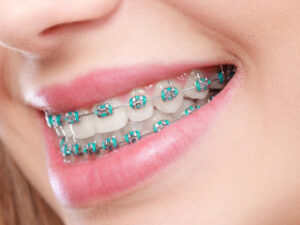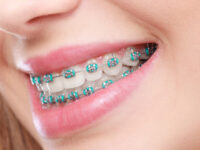Benefits of Dental Braces
Misaligned teeth create speech impediments like lisps. Straight teeth make it easier to pronounce words clearly and reduce slurring.
Las Vegas Braces consist of small brackets and arch wires that apply gradual pressure over time to straighten your teeth. In addition to providing cosmetic benefits, braces can help prevent certain oral health issues.

Besides the improved appearance of straight teeth and a properly aligned jawline, braces can also help enhance one’s facial shape. Asymmetrical facial features, such as uneven spacing or crowded teeth, can make the cheeks look too large for the rest of the face. On the other hand, if the lips are too pronounced or a person has a chin that looks weak and undefined, they may feel self-conscious about their smile. By correcting these asymmetrical issues, braces can improve the balance of a person’s facial features and increase their self-confidence.
Aside from being more aesthetically pleasing, straighter teeth are easier to clean and floss, which will prevent problems like cavities, chipped teeth or gum disease. Crooked teeth tend to be more difficult to brush because they have nooks and crannies where bacteria can hide, but when straighter teeth are in place, it’s much easier to reach all areas of the mouth and keep them healthy.
Dental braces exert a constant light pressure on the teeth to help them move into a healthier, more attractive position. They generally consist of a series of brackets that are bonded to each tooth and a metal wire that threads through them. The wire is bent to reflect the bite that will be in place after treatment. This wire, which is known as an arch wire, is tightened and loosened frequently to create the necessary pressure on the teeth to move them.
Today’s brackets are small, sleek and more discreet than those from a decade or two ago. In addition, newer materials provide a gentler pressure to help patients get the results they want more quickly. Braces can be used on people of all ages, but there is a window of opportunity during childhood and adolescence when the bones are still growing and more flexible to accommodate treatment. Once this window has passed, it can be difficult to widen the palate or shift the teeth into a more favorable alignment.
While braces are often used to correct crooked teeth and a bad “bite”, they can also help with chewing. This is because straightening crowded teeth can free up space for the back teeth, which makes it easier to chew and eat. It can also reduce the risk of tooth decay, gum disease or even bone loss.
When wearing dental braces, it is important to eat foods that are soft or cut into smaller pieces. This is because hard foods can damage the brackets and wires of the orthodontic appliance. Sticky and chewy foods, such as taffy or caramel, are particularly problematic because they may get stuck to the brackets. Other troublesome foods include ice cubes, popcorn kernels and raw vegetables.
Soft foods that are easy on the teeth and gums include mashed potatoes, noodles, soups, fruit smoothies, yogurt and eggs. Eggs are a good source of protein and they can be prepared in many ways, including scrambled, poached or fried. For more challenging foods, try cutting them into smaller pieces to make them easier to chew.
If you do eat foods that are off-limits for people with braces, be sure to brush your teeth immediately after eating and rinse thoroughly. This can prevent food debris from staying in the mouth and irritating the gums. In addition, it is a good idea to drink plenty of water throughout the day. Water can help flush away bacteria and sugars that lead to tooth decay and strengthen the enamel of your teeth. It can also prevent dehydration, which is a common problem among people with braces. A dry mouth can also cause sores and increase the likelihood of infections in the gums and tongue.
When teeth are misaligned, it can affect how clearly you pronounce words. This can lower your self-esteem and make you frustrated and embarrassed about speaking in public. The good news is that adult braces can help improve your speech by adjusting the positioning of the teeth. When the teeth are properly aligned, you can pronounce words more easily and without slurring.
Additionally, dental braces can prevent future complications by addressing problems like crooked teeth or a bad bite. These issues may put pressure on certain areas of your mouth, causing them to wear down more quickly or lead to a painful condition known as TMJ. The good news is that correcting these problems with dental braces can reduce pain and discomfort in your jaw, ear, and muscles on the side of your face.
Another way that orthodontic treatment can improve your speech is by reducing the need to clench or grind your teeth. This habit can cause the jaw bone to erode over time and can lead to tooth loss and other dental problems. Braces can help prevent this by redistributing the pressure on your teeth and gums.
In addition to helping you speak more clearly, dental braces also help you feel confident about your smile. Despite any discomfort or inconveniences that you might experience during the process, it is important to remember that the results of your treatment will be worth it in the long run. If you have any concerns about how your speech will be affected during or after treatment, talk to your orthodontist. They can give you advice on how to deal with any changes in your speech and recommend a speech or language therapy service if needed.
A key benefit of braces is that they help to prevent bone loss in the jaw. Over time, misaligned teeth can lead to bacterial build-up that wears down the enamel of the teeth and even erodes the roots and jawbones. This can affect not only your oral health but also your overall health as eroded roots and gums are more susceptible to cavities, infection, and other serious dental and general health issues.
Straighter, properly aligned teeth with fewer gaps and spaces are more easily cleaned. This can reduce the bacteria that cause bad breath as brushing and flossing are more effective against hard-to-reach areas where plaque thrives.
Having straighter, properly aligned teeth can also aid digestion. Before food enters your stomach, it must be partially broken down by your teeth and chewed into smaller pieces. With crooked or overcrowded teeth, this can be difficult to do. Braces can help to correct a misaligned bite, which in turn helps with digestion.
Modern orthodontic braces use a flexible arch wire that is threaded between brackets and affixed with elastic or metal ligatures. This is adjusted frequently to apply a light, constant force to move teeth into their desired positions. They also use heat-sensitive materials to minimize discomfort for the patient, and they are available in a variety of colors.
Getting braces at an early age can help ensure that the best results are obtained. It is important to note that the window of opportunity for the two-phase treatment may close if the palate expands too much by the time a child is 12 or 13. Fortunately, there are other methods to correct mild tooth crowding and improve a bad bite later in life.
The crooked teeth and excessive spaces between the teeth of people with malocclusion can become breeding grounds for harmful oral bacteria that cause gum disease. When left untreated, gum disease can lead to severe infections in the mouth.
Wearing braces to correct malocclusion can prevent the need for more invasive and expensive dental procedures in the future. In addition, by reducing the crowded teeth and spaces between them, the risk of plaque build-up that leads to tooth decay is also reduced.
Crowded teeth have hidden nooks and crannies that are difficult to clean with a toothbrush and floss, which can lead to cavities, gum disease and halitosis (bad breath). By straightening the crowded teeth and reducing the space between them, braces make it easier to maintain good oral hygiene practices.
Teeth that are not properly aligned can put uneven pressure on specific points of the jaw, causing bone erosion over time. This can lead to painful temporomandibular joint disorders (TMD), and braces can help correct bite alignment issues by evenly distributing the force of chewing across all of the teeth.
The proper alignment of teeth also makes it more efficient to chew food, which can lead to better digestion. Teeth that are not correctly aligned cannot adequately break down and digest the food before it reaches the stomach, which can lead to digestive problems like abdominal discomfort, irritable bowel syndrome and chronic constipation. Braces can address bite and alignment issues that may be causing these problems, improving your digestive health. For more information on how braces can improve your oral health, contact our team. We are dedicated to helping patients of all ages enjoy healthy and confident smiles.





